The Golf Swing and Traditional Dogma
I ask every first-time student to do this “drill”- Get into your address position and look to see which shoulder is lower
- Get into your impact position and look to see which shoulder is lower
- Get into your top of backswing position and look to see which shoulder is lower
 So then golfers intuitively bent forward because the clubs were short (or because they were tall!). Do you think Mary Queen of Scots or Old Tom Morris had a fixation about “spine angles”?
So then golfers intuitively bent forward because the clubs were short (or because they were tall!). Do you think Mary Queen of Scots or Old Tom Morris had a fixation about “spine angles”? 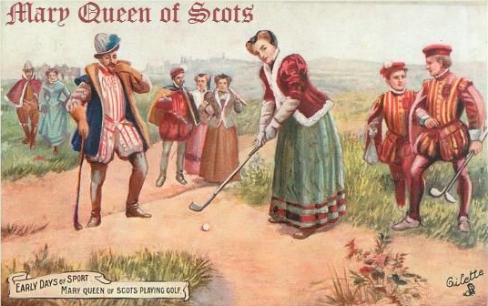 .
. 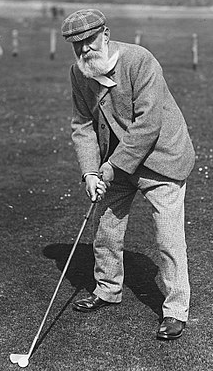 [To digress: the only things we MUST DO in a golf swing are (Other than have good speed):
[To digress: the only things we MUST DO in a golf swing are (Other than have good speed):- Arrive at the ball from an inside path
- Connect the ball at its near, trail-side quadrant.
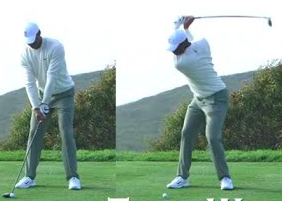
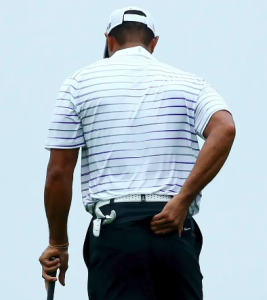 THE SCIENTIFIC FACTS:
THE SCIENTIFIC FACTS:- The forward spinal tilt at address is accompanied (by tradition) by a torso position at the top which may be visually observed as the lead side (shoulder, hip, knee) being lower than the trail side at the top of the backswing. It involves a combination of forward flexion, side-bend and rotation. However, from that top of backswing position, the downswing is expected to produce the sequence of pelvis-before-thorax (or shoulder, if you prefer) HORIZONTAL rotation. Now the muscles that can provide horizontal rotation of the pelvis are the gluteal muscles, but they require the pelvis to be level (not lead side down and trail side up) to act effectively. If, instead, a golfer uses the external obliques at the front of the torso, along with the trail side pectoralis major and latissimus dorsi to start the downswing (much easier), one gets an over-the-top movement as these muscles contract downwards and forward. BRIEFLY, THEN, the TYPICAL TOP OF BACKSWING POSITION cannot be easily undone by THE MUSCLES WE HAVE.
- Equally importantly, the brain and spinal cord were really not designed for golf, but rather for hunter-gatherers whose main activities were to run (lower limbs) and gather fruit/eat (upper limbs). All the parts of the central nervous system (ie brain and spinal cord) focus their resources on controlling muscles of the extremities (arms and legs), while having little input into torso movements. (a really detailed article here: https://www.minimalistgolfswing.com/the-brain-and-the-mgs/). Thus, while motor control theory tells us that the brain is very capable of coordinating many movements within a well-learned skill, it will probably simply try to “do its best” which may not be adequate for the sophisticated pelvis-before-thorax movement a golf downswing requires, based on its complex, three dimensional, top of backswing position. In short, THE TYPICAL TOP OF BACKSWING POSITION cannot be undone in perfect sequence during the ever-changing situation in golf play, by the HUMAN CENTRAL NERVOUS SYSTEM.
- Over the top shots
- Too limited a space between the trail shoulder and wrist, making straightening of the trail elbow and wrist at the correct time and in the correct directions inconsistent. This in turn results in the dreaded two-way, unpredictable miss.
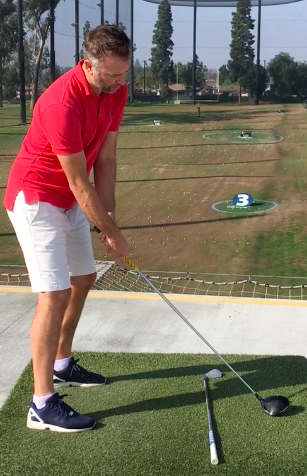 Why should anyone trust this information? It is based on either the text-books in the subjects of anatomy, motor control and biomechanics and/or all golf swing research ever conducted and/or my own 27 years of research on the golf swing, including for my recently completed doctoral dissertation. So, if you'd like to know how to get into positions and make movements which will improve performance and reduce some injury risk factors, get in touch! For in-person and online lessons contact me at: www.YourGolfGuru.com For video lessons: www.mgs.golf For inquiries on hosting/marketing certification courses for golf instructors or health care professionals (including all the basic sciences that are a must for everyone in the business of golf): www.YourGolfGuru.com Kiran Kanwar, Ph.D., LPGA Master Golf Instructor.
Why should anyone trust this information? It is based on either the text-books in the subjects of anatomy, motor control and biomechanics and/or all golf swing research ever conducted and/or my own 27 years of research on the golf swing, including for my recently completed doctoral dissertation. So, if you'd like to know how to get into positions and make movements which will improve performance and reduce some injury risk factors, get in touch! For in-person and online lessons contact me at: www.YourGolfGuru.com For video lessons: www.mgs.golf For inquiries on hosting/marketing certification courses for golf instructors or health care professionals (including all the basic sciences that are a must for everyone in the business of golf): www.YourGolfGuru.com Kiran Kanwar, Ph.D., LPGA Master Golf Instructor.